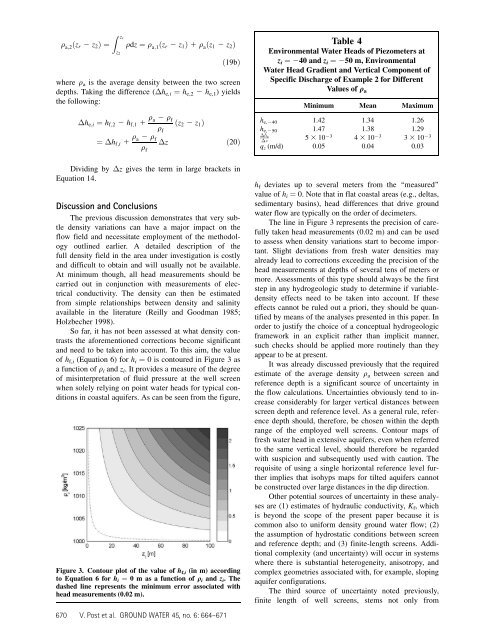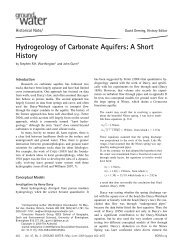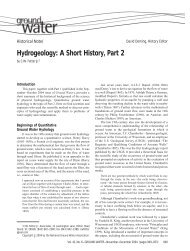Using Hydraulic Head Measurements in Variable ... - Info Ngwa
Using Hydraulic Head Measurements in Variable ... - Info Ngwa
Using Hydraulic Head Measurements in Variable ... - Info Ngwa
Create successful ePaper yourself
Turn your PDF publications into a flip-book with our unique Google optimized e-Paper software.
Z zr<br />
qa;2ðzr 2 z2Þ ¼<br />
z2<br />
qdz ¼ q a;1ðzr 2 z1Þ 1 q aðz1 2 z2Þ<br />
ð19bÞ<br />
where qa is the average density between the two screen<br />
depths. Tak<strong>in</strong>g the difference ( he, i ¼ he,2 2 he,1) yields<br />
the follow<strong>in</strong>g:<br />
he;i ¼ hf;2 2 hf;1 1 q a 2 q f<br />
q f<br />
¼ hf;i 1 q a 2 q f<br />
q f<br />
ðz2 2 z1Þ<br />
z ð20 Þ<br />
Divid<strong>in</strong>g by z gives the term <strong>in</strong> large brackets <strong>in</strong><br />
E quation 14.<br />
Discussion and C onclusions<br />
The previous discussion demonstrates that very subtle<br />
density variations can have a major impact on the<br />
flow field and necessitate employment of the methodology<br />
outl<strong>in</strong>ed earlier. A detailed description of the<br />
full density field <strong>in</strong> the area under <strong>in</strong>vestigation is costly<br />
and difficult to obta<strong>in</strong> and will usually not be available.<br />
At m<strong>in</strong>imum though, all head measurements should be<br />
carried out <strong>in</strong> conjunction with measurements of electrical<br />
conductivity. The density can then be estimated<br />
from simple relationships between density and sal<strong>in</strong>ity<br />
available <strong>in</strong> the literature (R eilly and G oodman 1985;<br />
H olzbecher 1998) .<br />
S o far, it has not been assessed at what density contrasts<br />
the aforementioned corrections become significant<br />
and need to be taken <strong>in</strong>to account. To this aim, the value<br />
of hf,i (E quation 6) for hi ¼ 0 is contoured <strong>in</strong> F igure 3 as<br />
a function of qi and zi. It provides a measure of the degree<br />
of mis<strong>in</strong>terpretation of fluid pressure at the well screen<br />
when solely rely<strong>in</strong>g on po<strong>in</strong>t water heads for typical conditions<br />
<strong>in</strong> coastal aquifers. As can be seen from the figure,<br />
Figure 3. C ontour plot of the value of hf, i (<strong>in</strong> m) accord<strong>in</strong>g<br />
to E q uation 6 for h i ¼ 0 m as a function of q i and z i. T he<br />
dashed l<strong>in</strong>e represents the m<strong>in</strong>imum error associated with<br />
head measurements (0 .0 2 m).<br />
670 V. P ost et al. GROUND WATER 45, n o. 6: 664–671<br />
T able 4<br />
E nvironmental W ater H eads of P iezometers at<br />
zi ¼ 24 0 and zi ¼ 25 0 m, E nvironmental<br />
W ater H ead G radient and V ertical C omponent of<br />
Specific D ischarge of E x ample 2 for D ifferent<br />
V alues of q a<br />
M <strong>in</strong>imum M ean M ax imum<br />
he,240 1.42 1.34 1.26<br />
he,250 1.47 1.38 1.29<br />
he<br />
z 5 3 10 23 4 3 10 23 3 3 10 23<br />
qz (m/d) 0 .0 5 0 .0 4 0 .0 3<br />
hf deviates up to several meters from the ‘ ‘ measured’’<br />
value of hi ¼ 0 . Note that <strong>in</strong> flat coastal areas (e.g., deltas,<br />
sedimentary bas<strong>in</strong>s) , head differences that drive ground<br />
water flow are typically on the order of decimeters.<br />
The l<strong>in</strong>e <strong>in</strong> F igure 3 represents the precision of carefully<br />
taken head measurements (0 .0 2 m) and can be used<br />
to assess when density variations start to become important.<br />
S light deviations from fresh water densities may<br />
already lead to corrections exceed<strong>in</strong>g the precision of the<br />
head measurements at depths of several tens of meters or<br />
more. Assessments of this type should always be the first<br />
step <strong>in</strong> any hydrogeologic study to determ<strong>in</strong>e if variabledensity<br />
effects need to be taken <strong>in</strong>to account. If these<br />
effects cannot be ruled out a priori, they should be quantified<br />
by means of the analyses presented <strong>in</strong> this paper. In<br />
order to justify the choice of a conceptual hydrogeologic<br />
framework <strong>in</strong> an explicit rather than implicit manner,<br />
such checks should be applied more rout<strong>in</strong>ely than they<br />
appear to be at present.<br />
It was already discussed previously that the required<br />
estimate of the average density q a between screen and<br />
reference depth is a significant source of uncerta<strong>in</strong>ty <strong>in</strong><br />
the flow calculations. Uncerta<strong>in</strong>ties obviously tend to <strong>in</strong>crease<br />
considerably for larger vertical distances between<br />
screen depth and reference level. As a general rule, reference<br />
depth should, therefore, be chosen with<strong>in</strong> the depth<br />
range of the employed well screens. C ontour maps of<br />
fresh water head <strong>in</strong> extensive aquifers, even when referred<br />
to the same vertical level, should therefore be regarded<br />
with suspicion and subsequently used with caution. The<br />
requisite of us<strong>in</strong>g a s<strong>in</strong>gle horizontal reference level further<br />
implies that isohyps maps for tilted aquifers cannot<br />
be constructed over large distances <strong>in</strong> the dip direction.<br />
O ther potential sources of uncerta<strong>in</strong>ty <strong>in</strong> these analyses<br />
are (1) estimates of hydraulic conductivity, Kf, which<br />
is beyond the scope of the present paper because it is<br />
common also to uniform density ground water flow; (2)<br />
the assumption of hydrostatic conditions between screen<br />
and reference depth; and (3) f<strong>in</strong>ite-length screens. Additional<br />
complexity (and uncerta<strong>in</strong>ty) will occur <strong>in</strong> systems<br />
where there is substantial heterogeneity, anisotropy, and<br />
complex geometries associated with, for example, slop<strong>in</strong>g<br />
aquifer configurations.<br />
The third source of uncerta<strong>in</strong>ty noted previously,<br />
f<strong>in</strong>ite length of well screens, stems not only from




